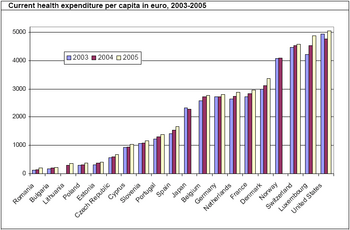This Statistics Explained article is outdated and has been archived - for recent articles on health see here.
- Data from April 2008. Most recent data: Further Eurostat information, Database.
Healthcare expenditure statistics present information on the provision and financing of healthcare in the European Union Member States, by referring to healthcare goods and services, its providers and financing agents.
Current expenditure on health measures the economic resources spent by a country on healthcare services and goods, including administration and insurance. So current expenditure includes, for example, nurses' wages, the costs of a nation-wide vaccination programme and payments for hospital cleaning services, among many others. Total healthcare expenditure represents current expenditure on health enlarged by the expenditure on capital formation (investments) of healthcare providers, for example the cost of an investment in a new hospital.
Main statistical findings
To collect data on healthcare expenditure, the System of health accounts and its related set of International classification for health accounts is used. The SHA shares the goals of the System of national accounts to constitute an integrated system of comprehensive, internally consistent, and internationally comparable accounts, which should as far as possible be compatible with other aggregated economic and social statistical systems.
The SHA is organised around a tri-axial system for recording health expenditure, by means of an International classification for health accounts (ICHA), defining:
- healthcare financing agents: who is paying?
- healthcare by function: for which services and goods?
- healthcare service provider industries: who is paid, who provides the services?
Financing agent (ICHA-HF): Mechanisms of healthcare financing are becoming increasingly complex in many countries with a wide range of institutions involved. The financing of healthcare is one of the reporting dimensions. At least a basic subdivision of public and private financing is reported in many cases. A detailed breakdown of expenditure on health by financing agents is an essential component of a comprehensive SHA.
Function category (ICHA-HC): The boundaries of a functionally defined healthcare system delimit the subject area of health accounts. This approach is “functional” in the sense that it refers to the purposes of healthcare. Healthcare in a country comprises the sum of activities performed either by institutions or individuals pursuing, through the application of medical, paramedical and nursing knowledge and technology, the purposes of:
- promoting health and preventing disease;
- curing illness and reducing premature mortality;
- caring for persons affected by chronic illness who require nursing care;
- caring for persons with health-related impairment, disability, and handicaps who require nursing care;
- assisting patients to die with dignity;
- providing and administering public health; and
- providing and administering health programs, health insurance and other funding arrangements.
The core functions of healthcare refer to the purposes listed above. Health-related functions such as the education and training of the health workforce, research and development in health and environmental health should be distinguished from the core functions. They can be very closely linked to healthcare in terms of activities, institutions and personnel, but should, as far as possible, be excluded when measuring activities belonging to core healthcare functions.
Provider category (ICHA-HP): The production and the provision of healthcare services along with their financing take place in a wide range of institutional settings that vary across countries. The way of organising healthcare services reflects the country-specific division of labour between providers of healthcare services which is becoming increasingly complex in many countries. A classification of healthcare providers organises the country-specific institutions into common, internationally applicable categories and provides tools for linking data on personnel and other resource inputs as well as output measurement.
Data sources and availability
The Joint health accounts data collection (a co-operation between Eurostat, OECD and WHO) started in 2005 and two further waves were launched in 2006 and 2007. The data presented here are the results of the first two waves (data for reference years 2003, 2004 and 2005).
Context
The System of health accounts (SHA), aligned with the System of national accounts, aims to provide policy makers and other stakeholders with a view on healthcare financing agents (who is paying?), healthcare by function (for which services and goods?) and healthcare service provider industries (who is paid, who provides the services?).
See also
Further Eurostat information
Publications
- Health expenditure, 2003-2005 - Data in focus 26/2008]
Database
- Health, see:
- Health care (hlth_care)
- Data
- Database
- Data
- Health care expenditure (hlth_sha)
- Health care expenditure - summary tables (hlth_sha_sum)
- Health care expenditure, % (hlth_sha_perc)
- Health care expenditure, per inhabitant (hlth_sha_inh)
Dedicated section
Methodology / Metadata
- Health care expenditure (ESMS metadata file — hlth_sha_esms)




